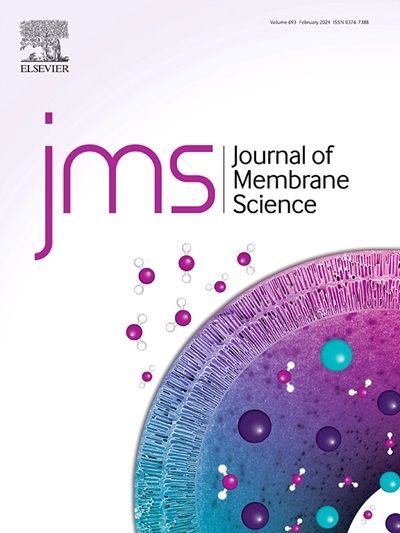Directional anchoring of cobalt metal sites in mixed matrix membranes via interfacial covalent grafting for synchronous separation of particulate matter and CO2
IF 8.4
1区 工程技术
Q1 ENGINEERING, CHEMICAL
引用次数: 0
Abstract
In the co-capture technology for particulate matter (PM) and carbon dioxide (CO2) using mixed matrix membranes (MMMs), concentration polarization at the membrane surface, along with the inappropriate selection and proportion of active layer and substrate, are primary factors influencing both separation efficiency and production performance. However, the fabrication of defect-free solid-gas separation membranes with enhanced permeability selectivity and phase compatibility remains a challenge due to the formation of substrate-filler interface defects and filler aggregation. In this study, the use of cobalt-coordinated conjugated microporous polymers (CMPs) as an adsorptive active layer for interfacial modification effectively mitigates the aggregation of porous fillers and enhances the interaction between the substrate and filler components, thereby forming MMMs with superior interfacial compatibility and selectivity towards harmful PM and mixed gas components. The Co-CMP-MWCNTs exhibited a capture efficiency for PM3.0 exceeding 99.9 % in acidic and alkaline environments, with a high ideal adsorption solution theory (IAST) selectivity of 160 for CO2/N2 mixed components. By comparing the experimental data with the calculations of density functional theory (DFT), the structure-activity relationship between the precise control of pore size and the interaction of active sites with guest molecules and the enhancement of membrane permeation selectivity was elucidated. Based on the structural regulation and polymerization optimization of porous fillers, by reducing particle agglomeration and improving the substrate-filler compatibility, the CMPs-based membranes can adjust the inherent trade-off between selectivity and permeability in the solid-gas mixed separation system, providing a theoretical basis for the precise design and rational creation of high-value-added membranes.

求助全文
约1分钟内获得全文
求助全文
来源期刊

Journal of Membrane Science
工程技术-高分子科学
CiteScore
17.10
自引率
17.90%
发文量
1031
审稿时长
2.5 months
期刊介绍:
The Journal of Membrane Science is a publication that focuses on membrane systems and is aimed at academic and industrial chemists, chemical engineers, materials scientists, and membranologists. It publishes original research and reviews on various aspects of membrane transport, membrane formation/structure, fouling, module/process design, and processes/applications. The journal primarily focuses on the structure, function, and performance of non-biological membranes but also includes papers that relate to biological membranes. The Journal of Membrane Science publishes Full Text Papers, State-of-the-Art Reviews, Letters to the Editor, and Perspectives.
 求助内容:
求助内容: 应助结果提醒方式:
应助结果提醒方式:


